
This page is part of © FOTW Flags Of The World website
Gay Pride / Rainbow Flag
Sexual Orientation Flags
Last modified: 2016-03-08 by randy young
Keywords: rainbow flag | baker (gilbert) | stripes: 6 | stripes: 7 | stripes: 8 | gay pride |
Links: FOTW homepage |
search |
disclaimer and copyright |
write us |
mirrors
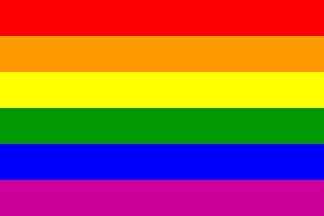
image by António Martins, 20 April 1999
See also:
External links:
The rainbow is a symbol of gay pride, as opposed to gay liberation, which used the pink triangle on various colored fields.
Jim Ferrigan, 14 February 2003
The plain 6 stripes does seem to be the flag of choice over the world and probably so for a simple reason of recognition: the flag is often use to mark "gay-friendly" (and in some places, "gay-safe") establishments, so you want to be sure that your target clientele will recognise you.
Marc Pasquin, 26 October 2004
The rainbow flag has become the easily-recognized colors of pride for the gay community. The multicultural symbolism of the rainbow is nothing new and it plays a part in many myths and stories related to gender and sexuality issues in Greek, Native American, African, and other cultures.
Marcus Schmöger, 26 August 2001
quoting from this page
The rainbow flag [meaning]:
- red: light;
- orange: healing;
- yellow: sun;
- green: calmness;
- blue: art;
- lilac: the spirit;
[black: AIDS awareness]
Marcus Schmöger, 26 August 2001
translating from EuroGay.NET
The Alyson Almanac: A Treasury of Information for the Gay and Lesbian Community describes Rainbow Flag as follows:
In 1978, Gilbert Baker of San Francisco designed and made a flag with six stripes representing the six colors of the rainbow as a symbol of gay and lesbian community pride. Slowly the flag took hold, offering a colorful and optimistic alternative to the more common pink triangle symbol. Today it is recognized by the International Congress of Flag Makers, and is flown in lesbian and gay pride marches worldwide. In 1989, the rainbow flag received nationwide attention after John Stout successfully sued his landlords in West Hollywood, when they prohibited him from displaying the flag from his apartment balcony. Meanwhile, Baker is still in San Francisco, and still making more flags.
In San Francisco, the Rainbow Flag is everywhere: it can be seen hanging from apartment windows throughout the city (most notably in the Castro district), local bars frequently display the flag, and Rainbow Flag banners are hung from lamp posts on Market Street (San Francisco's main avenue) throughout Pride Month. Visiting the city, one can not help but feel a tremendous sense of pride at seeing this powerful symbol displayed so prominently.
Although the Rainbow Flag was initially used as a symbolof pride only in San Francisco, it has received increased visibility in recent years. Today, it is a frequent sight in a number of other cities as well — New York, West Hollywood, and Amsterdam, among them. Even in the Twin Cities, the flag seems to be gaining in popularity. Indeed, the Rainbow Flag reminds us that ours is a diverse community — composed of people with a variety of individual tastes of which we should all be proud.
Sources used for this article were found at Quatrefoil Library in St. Paul, and include:
- [zom86] "Vexed by Rainbows" by Paul Zomcheck, in Bay Area Reporter (June 26, 1986)
- [u9s89a] "Rainbow Flag" in The Alyson Almanac (1989)
- [u9s90a] "The Rainbow Flag," in Parade 90: San Francisco Gay/Lesbian Freedom Day Parade and Celebration (June 24, 1990)
Christopher Pinette, 12 June 1996
For a long time past the rainbow flag has been a sign under which gays and lesbians declare themselves to homosexuality. The rainbow colours symbolize plurality and love of life. The original version had been designed in 1978 by Gilbert Baker, an artist from San Francisco, and has been changed several times since then due to printing reasons (colours). Over the last years the flag has gained popularity as a symbol. The open display of the flag in different forms (e.g. car sticker, button on clothes) shows, that the gay community has enormously gained in self-confidence. They don't hide themselves any longer, but openly show their gayness in the public.
Marcus Schmöger, 26 August 2001
translating from BcWsD.COM
It is interesting to note that the flag's colors are used for many other items also - such as mugs, beach towels, T-shirts, etc. - for sale in souvenir shops. Sometimes the actual flag is reproduced and sometimes the colors are used for non-flag design elements, e.g. a T-shirt with six small beach umbrellas embroidered across the front, one in each color of the flag.
Tom Gregg, 20 August 2001
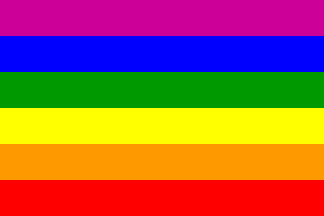
image by António Martins, 12 January 2000
There is no "right-side up" for this flag. It may be flown either red up or purple up. This information comes directly form Gilbert Baker, the gay artist who conceived of the "The Rainbow Flag" as a symbol of Gay Pride.
James Ferrigan, 26 July 1999
I guess that this applies to the plain rainbow flag and to the horizontally symmetrical variants (pink triangle at hoist, etc.). However, things like the white lambda on a rainbow background or rainbow smiley flag can't be freely hoisted upside down, meaning that they may be produced either with red up or with purple up. However, I'd say that most of those variations are more often with red stripe up, as well as plain rainbow flags, especially those that are produced with such a hoisting device that they cannot be inverted.
António Martins, 27 July 1999
True enough, and yet it somehow underscores that very point, each gay person is free to be "oriented" in any direction, the freedom it give to groups is likewise unique. A survey we conducted in San Francisco showed that the ratio was about 4 to 1 for red to purple up. We used to tell customers fly red up if you're in a good mood! The rainbow with the lambda did come both ways in the 1980s, also we would also give the customer a choice when mounting the flag on poles. The "red up," so far as I know, came from an incorrect handout from Lambda Rising in Wash D.C.
James Ferrigan, 28 July 1999
I work for COC Nederland, which is the oldest existing gay rights organisation in the world (founded 1946). I have noticed that in Western Europe we use the flag red stripe up, while our colleagues in Eastern Europe use it the other way round. I've seen this use in Romania, Bulgaria and Moldova. The countries in former Yugoslavia use it with the red stripe up, maybe because Yugoslavia was always a "Western European" country.
Maxim van Ooijen, 12 June 2005
The Gay Pride Flags I observed in Provincetown, the US East Coast's gay Mecca, were being flown with the red stripe at the top.
Tom Gregg, 20 August 2001
Not only that there is no "right-side up," but the flags with red and purple stripes up are frequently used together as well. A good example is the photo found here (image). Unfortunately, there is no info on the origin of the photo, except that it was clearly taken before 3 October 2012 and that it is from some Gay Pride event. It is used merely as an illustration of the article, which was published on the date given above, but is rather vaguely related to its content.
Tomislav Todorovic, 28 December 2014
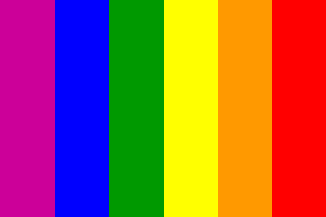
image by Joàn-Francès Blanc, 7 July 1999
On a bar at Bergerac/Brageirac (France) displayed at the entrance of the city, a gay flag with vertical stripes.
Joàn-Francès Blanc, 7 July 1999
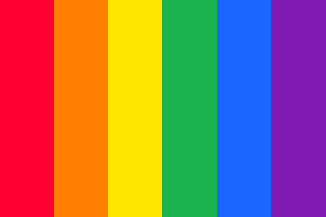
image by Tomislav Todorovic, 14 June 2015
Similar flags with red stripe at the hoist were carried at Atlanta Pride 2009 in Atlanta, Georgia. The photo is available here.
Tomislav Todorovic, 14 June 2015
This flag was also used in Portland, Maine, at the South Maine Pride 2006.
Tomislav Todorovic, 1 August 2015
Flags with the same design, except somewhat different color shades, were used in Bucharest, Romania at the GayFest 2009 parade. Photos from the event can be found here, here, here, here, here, here, and here. These flags were used again at GayFest 2010, as can be seen here, here, and here.
Tomislav Todorovic, 26 December 2015
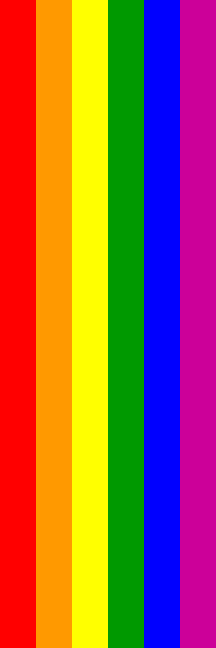
image by Marcus Schmöger, 22 August 2001
This is a vertical variant of the rainbow flag, actually a Knatterfahne (flapping flag), i.e. a vertical flag with vertical stripes, the red at the hoist. Seen during the CSD (Christopher Street Day) Parade in Munich.
Marcus Schmöger, 22 August 2001
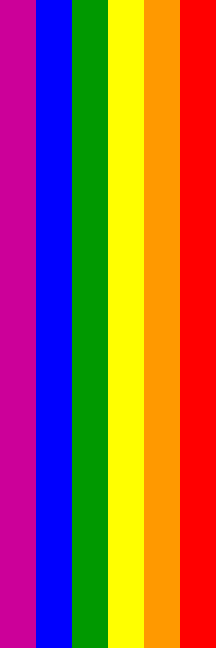
image by Tomislav Todorovic, 6 July 2013
Just like the horizontal variant may be flown either with red or with purple at the top, the "portrait" vertical variant may be flown either with red or with purple at the hoist. The flags with the purple at the hoist were used at the Pride Parade in Jerusalem, on 26 June 2008. Their hoisting was a combination of those of German Knatterflaggen and Auslegerflaggen, only with both the staff and the outrigger going each through a sleeve.
The flags with the same pattern, only hoisted like German Haengeflaggen, were used in Tel Aviv, on 18 July 2005 and in Jerusalem, on 25 June 2009.
Tomislav Todorovic, 6 July 2013

image by Tomislav Todorovic, 9 June 2015
Another variant, with colors arranged horizontally but in shape similar to the German Auslegerflaggen, only with the outrigger going through the flag sleeve, was seen at Stockholm Pride Parade on 31 July 2010. The photos can be found here and here.
Tomislav Todorovic, 9 June 2015
Similar flags, only a bit less oblong, were also used in Hannover, Germany, during the "Demo for All" (Demo für Alle) rally on 22 November 2014. The photos from the event can be found here, here, here, here, here, here and here.
Tomislav Todorovic, 19 June 2015
A flag with this design and hoisting like the German Knatterflaggen was seen in Columbus, Ohio, on 17 July 2007.
Tomislav Todorovic, 27 June 2015
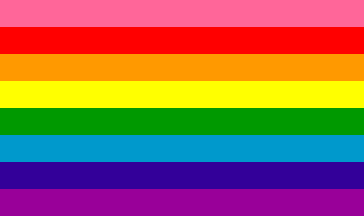
image by António Martins, 15 October 2003; updated by Tomislav Todorovic, 1 August 2015
"Now, more than 20 years later, Baker has decided it is time to bring his initial design out of the closet." ... "But the new-old flag, which was unfurled with no fanfare or explanation on Valentine's Day, left many Castro" (San Francisco, Calif., U.S.) "residents and tourists puzzled." ... "the prospect of having to revert to an eight-color flag after more than 20 years of using the six-color version is cause for major headaches." ... "So far, Baker says he does not plan to insist that all the rainbow flags flying in the Castro be changed to show their true colors; only the big one honoring [Harvey] Milk" ... "the nation's first openly gay [politician assassinated] in 1978). 'The idea of the rainbow is what counts,' he says."
Knut A. Berg, 9 May 2000
quoting from sfWeekly.COM
However, contrasting written descriptions of the original flag against the currently proposed 8-stripe version suggests that some color shades are noticeably different.
António Martins, 1 April 2005
External links:
reported by Leo Bauer, 7 July 2003
As exposed above, Gilbert Baker has tried to re-introduce the 8-striped version of the Gay Rainbow Flag in 2000. As can be read here, he kept doing so since then: in 2004, he created a collection of flags named "Out 2 Vote" by adding the colors of original Gay Rainbow Flag to the designs of flags of all U.S. states and territories. The whole collection can be viewed at Baker's website.
Tomislav Todorovic, 1 September 2013
The flag was used in New York City on 12 November 2008, during the demonstration in support of the marriage equality, at the San Francisco Pride on 28 June 2009, at the National Equality March in Washington, DC, on 11 October 2009, and in San Diego, California, in February 2012 (exact date not specified). One of the latest occasions when it was used was in Washington, DC, on 28 April 2015, at the rally during the session of the Supreme Court of the USA at which the arguments were heard concerning whether same-sex marriage is a constitutional right (ruled that it is, on 26 June 2015). The photos from the rally can be found here and here.
The flag is being introduced outside the USA as well. It was used in Sweden, at Stockholm Pride 2008 and Stockholm Pride 2009, and one of the most recent examples of its use was in Riga, Latvia, on 20 June 2015, with the photos available here and here.
Tomislav Todorovic, 27 June 2015
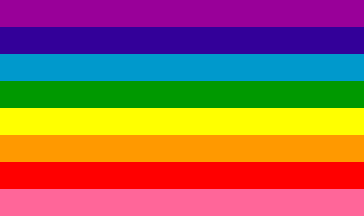
image by Tomislav Todorovic, 1 August 2015
Although usually flown with the pink stripe at the top, the flag is sometimes used with the reversed color order. Such was the case in Detroit, at Motor City Pride 2009.
Tomislav Todorovic, 1 August 2015
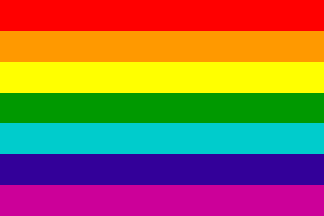
image by Tomislav Todorovic, 1 September 2013
The 7-striped version seems to have been re-appearing recently as well. A photo of this flag, hoisted together with the U.S. national flag, can be found here (image). However, the fifth stripe from the top is not blue, which was
described as used on the original 7-striped flag, but turquoise, which was the part of original Baker's design.
Tomislav Todorovic, 1 September 2013
The seven-striped rainbow flag was hoisted in front of the Legislative building in Regina, Saskatchewan, on 2014-02-09, as shown in a video, @ 0:01 - 0:16, available
here. A photo of the flag hoisted in front of the building is available at the same page, as well as a close-up of the flag. Another close-up is available here
(photo) and another photo showing both the flag and the building can be found at the Saskatoon Pride Festival Facebook pages.
An unrelated photo of hoisting the flag in the USA can be found
here
(image) and although it is not quite clear, it is possible that the flag was
hoisted with the purple stripe at the top.
Tomislav Todorovic, 24 June 2014
The flag use is spreading outside the North America as well. As early as in 2007, it was used at Madrid Pride (Orgullo Madrid). The photo of a building flying the flags in honor of the event can be found here. The flag has become especially widespread in India. Its photos from Chennai Pride 2009 can be found here, here and here. A photo from Bengaluru Pride 2009 can be found here. The way the photographed man wears it resembles the shawls in party colors frequently worn by the activists and supporters of political parties in India and might be influenced by that custom. More photos from the Bengaluru Pride 2010 can be found here, here, and here. The flag was also used at Belfast Pride Parade 2013. More photos from New Delhi, taken on 28 November 2014, can be found here, here, here, and here.
Tomislav Todorovic, 28 June 2015
The flag was also seen in Phuket, Thailand, at the Phuket Pride 2014.
Tomislav Todorovic, 24 October 2015
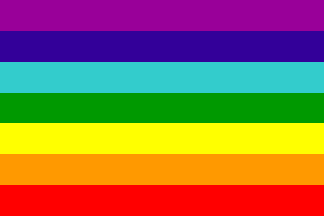
image by Tomislav Todorovic, 28 June 2015
Just like the 6-striped version, the 7-striped one does not have the "right side up" and may be flown with the reversed color order. Flags with purple stripe at the top, photographed at Chennai Pride 2009, can be seen here, here and here. Their photos from Chennai Pride 2010, sometimes used together with the 6-striped flags, can be found in the photo gallery at Chennai Dost website. Such flags were also seen at Stockholm Pride 2014.
Tomislav Todorovic, 28 June 2015
Novelty 7-stripe versions
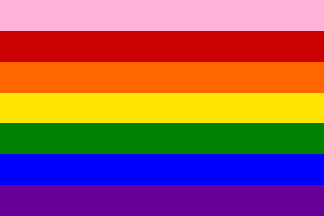
image by Tomislav Todorovic, 7 September 2014
Gilbert Baker's efforts to promote the use of his original eight-striped design, which did have some success, albeit limited, also seem to have had interesting side effects - revival of interest in the original seven-striped variant, but also the creation of another seven-striped variant, which keeps pink and omits turquoise color. It has appeared at
Guatemala Pride 2012 (Orgullo Guatemala 2012) in Guatemala City, on 2012-06-30. The photos are available here, here and here.
Tomislav Todorovic, 7 September 2014
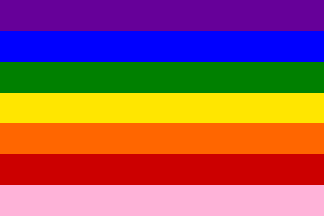
image by Tomislav Todorovic, 7 September 2014
An earlier photo, from the Guatemala Pride 2011 (Orgullo Guatemala 2011), can be seen here
(image), but it shows the variant with reversed order of colors. The same flag was used at the celebration of the International Day Against Homophobia in Guatemala City, on 2012-05-17.
Tomislav Todorovic, 7 September 2014
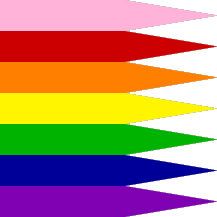
image by Tomislav Todorovic, 7 September 2014
Even before all these events, a more complex flag with the "pink stripe up" pattern was used at the Santa Cruz Pride 2008, in Santa Cruz, California. Its length was smaller than width and each of seven
stripes was ending with a pointed tongue in same color. The photos can be found here, here, here and here. It is possible that there are also earlier flags with this color pattern, which are yet to be discovered.
Tomislav Todorovic, 7 September 2014
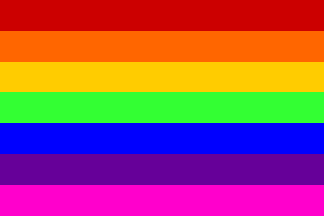
image by Tomislav Todorovic, 1 July 2015
Another flag with the same colors, but pink placed next to the purple, at the very bottom of the flag, has been used in India since at least 2011. Its photos from Chennai Rainbow Pride 2011 can be found here and here. The flag was used again at Chennai Rainbow Pride 2012, as shown here, and at Chennai Rainbow Pride 2014, as shown here and here. Along with a deep shade of pink, much more so than originally introduced by Gilbert Baker, the flag displays rather dark shades of other colors, except green, which is unusually light for a rainbow flag.
Tomislav Todorovic, 1 July 2015

image by Tomislav Todorovic, 5 March 2016
An unusual rainbow flag with ten colors has appeared at the World Pride London 2012. Its photos can be found here, here, here, and here. The colors are, from top to bottom: red, orange, yellow-orange (much like the FOTW color Y+), yellow, light green (inclining somewhat towards yellow), dark green, light blue (inclining a bit towards green), dark blue, indigo and violet. The flag shape was also unusual: each field was in form of a trapezium with the top edge shorter than the bottom one, so that the fly edge of the flag was in form of 10 pointed tongues.
Tomislav Todorovic, 5 March 2016

















